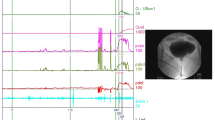Abstract
Introduction and hypothesis
Common options for management of primary bladder neck obstruction (PBNO) in women include medications and surgical treatment. Less invasive treatment such as bladder neck botulinum toxin injection can be an alternate therapy in patients with failed conservative management. In this study, we describe the subjective and objective outcomes, patient satisfaction, and willingness for repeat treatment with bladder neck botulinum toxin injection in females with PBNO.
Methods
A retrospective analysis of ten female PBNO patients managed with bladder neck botulinum toxin injection was performed. Subjective parameters were quantified with symptom assessment, International Prostate Symptom Score (IPSS), and Quality of life (QoL) score. Objective parameters were assessed with maximum flow rate (Qmax) in uroflowmetry and postvoid residual (PVR).
Results
The mean pre-treatment IPSS, QoL score, Qmax, PVR was 24.2 ± 5.0, 4.8 ± 0.63, 5.73 ± 3.18 ml/s, and 210 ± 66 ml, respectively. Seven of the ten patients subjectively improved (IPSS 12.9 ± 9.6, QoL2.9 ± 1.6, p < 0.05). Three patients improved objectively (mean Qmax 17.3 ± 2.7 ml/s, PVR 42.7 ± 7.5 ml, p < 0.05). Three patients accepted repeat botulinum toxin injection. Three patients who showed no improvement underwent bladder neck incision with resolution of symptoms.
Conclusion
Botulinum toxin can be an intermediary therapy in female patients with PBNO who want a minimally invasive procedure.

Similar content being viewed by others
References
Padmanabhan P, Nitti VW. Primary bladder neck obstruction in men, women, and children. Curr Urol Rep. 2007;8(5):379–84. https://doi.org/10.1007/s11934-007-0035-3.
Kumar A, Mandhani A, Gogoi S, Srivastava A. Management of functional bladder neck obstruction in women: use of alpha-blockers and pediatric resectoscope for bladder neck incision. J Urol. 1999;162(6):2061–5. https://doi.org/10.1016/s0022-5347(05)68101-3.
Athanasopoulos A, Gyftopoulos K, Giannitsas K, Perimenis P. Effect of alfuzosin on female primary bladder neck obstruction. Int Urogynecol J Pelvic Floor Dysfunct. 2009;20(2):217–22. https://doi.org/10.1007/s00192-008-0749-x.
Markić D, Valenčić M, Maričić A, Krpina K, Rahelić D, Ahel J, Rubinić N, Orlić L, Rački S. Transurethral incision of the bladder neck in a woman with primary bladder neck obstruction after kidney transplantation. Case Rep Transplant. 2015;2015: 312084. https://doi.org/10.1155/2015/312084.
Blaivas JG, Flisser A, Tash JA. Treatment of primary bladder neck obstruction in women with transurethral resection of the bladder neck. J Urol. 2004;171(3):1172–5. https://doi.org/10.1097/01.ju.0000112929.34864.2c.
Pischedda A, Pirozzi Farina F, Madonia M, Cimino S, Morgia G. Use of alpha1-blockers in female functional bladder neck obstruction. Urol Int. 2005;74(3):256–61. https://doi.org/10.1159/000083559.
Lee YS, Lee KS, Choo MS, Kim JC, Lee JG, Seo JT, Lee JZ, Lee JY, Oh SJ, Na YG. Efficacy of an alpha-blocker for the treatment of nonneurogenic voiding dysfunction in women: An 8-week, randomized, double-blind, placebo-controlled trial. Int Neurourol J. 2018;22(1):30–40. https://doi.org/10.5213/inj.1834904.452.
Shen W, Ji H, Yang C, Zhang H, Xiong T, Wu X, Zhang J, Zhou Z. Controlled transurethral resection and incision of the bladder neck to treat female primary bladder neck obstruction: Description of a novel surgical procedure. Int J Urol. 2016;23(6):491–5. https://doi.org/10.1111/iju.13085.
Ek A, Alm P, Andersson KE, Persson CG. Adrenergic and cholinergic nerves of the human urethra and urinary bladder. A histochemical study. Acta Physiol Scand. 1977;99(3):345–52. https://doi.org/10.1111/j.1748-1716.1977.tb10387.x.
Zhang HL, Huang ZG, Qiu Y, Cheng X, Zou XQ, Liu TT. Tamsulosin for treatment of lower urinary tract symptoms in women: a systematic review and meta-analysis. Int J Impot Res. 2017;29(4):148–56. https://doi.org/10.1038/ijir.2017.12.
Sussman RD, Drain A, Brucker BM. Primary bladder neck obstruction. Rev Urol. 2019;21(2–3):53–62.
Jonas U, Petri E, Hohenfellner R. Indication and value of bladder neck incision. Urol Int. 1979;34(4):260–5. https://doi.org/10.1159/000280271.
Grønbaek K, Struckmann JR, Frimodt-Møller C. The treatment of female bladder neck dysfunction. Scand J Urol Nephrol. 1992;26(2):113–8. https://doi.org/10.1080/00365599.1992.11690441.
Jin XB, Qu HW, Liu H, Li B, Wang J, Zhang YD. Modified transurethral incision for primary bladder neck obstruction in women: a method to improve voiding function without urinary incontinence. Urology. 2012;79(2):310–3. https://doi.org/10.1016/j.urology.2011.11.004.
Zhang P, Wu ZJ, Xu L, Yang Y, Zhang N, Zhang XD. Bladder neck incision for female bladder neck obstruction: long-term outcomes. Urology. 2014;83(4):762–6. https://doi.org/10.1016/j.urology.2013.10.084.
Kuo HC. Botulinum A toxin urethral injection for the treatment of lower urinary tract dysfunction. J Urol. 2003;170(5):1908–12. https://doi.org/10.1097/01.ju.0000091281.50081.f0.
Ip C, Yao H, Plagakis S, Tse V, Chan L, Gani J, O’Connell H. Outcomes of botulinum toxin A in the treatment of primary bladder neck obstructionz. https://www.ics.org/2019/abstract/686. 26 Jan 2022.
Pradhan AA. Botulinum toxin: An emerging therapy in female bladder outlet obstruction. Indian J Urol. 2009;25(3):318–20. https://doi.org/10.4103/0970-1591.56181.
Author information
Authors and Affiliations
Contributions
Atanu Kumar Pal: Data Collection, Manuscript writing.
Sidhartha Kalra: Concept, Project development, Intervention, Final drafting, Final editing and approval.
Lalgudi Naryanan Dorairajan: Final editing and approval.
Sreerag Kodakkattil Sreenivasan: Project development, Review of the manuscript.
Ramanitharan Manikandan: Final editing and approval.
Deepanshu Aggarwal: Manuscript writing, Editing.
Corresponding author
Ethics declarations
Financial disclaimer/Conflict of interest
None.
Additional information
Publisher's note
Springer Nature remains neutral with regard to jurisdictional claims in published maps and institutional affiliations.
Rights and permissions
Springer Nature or its licensor holds exclusive rights to this article under a publishing agreement with the author(s) or other rightsholder(s); author self-archiving of the accepted manuscript version of this article is solely governed by the terms of such publishing agreement and applicable law.
About this article
Cite this article
Pal, A.K., Kalra, S., Dorairajan, L.N. et al. Outcomes of bladder neck botulinum toxin injection for female primary bladder neck obstruction—does subjective improvement correlate with an objective assessment?. Int Urogynecol J 34, 1049–1054 (2023). https://doi.org/10.1007/s00192-022-05319-x
Received:
Accepted:
Published:
Issue Date:
DOI: https://doi.org/10.1007/s00192-022-05319-x




